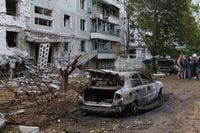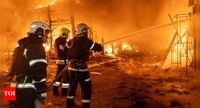In the early hours of October 5, 2025, the western Ukrainian city of Lviv awoke to the thunder of explosions and the urgent whine of air raid sirens. Russia had unleashed a barrage of missiles and drones that pounded the region for hours, marking the most intense attack on Lviv since the full-scale invasion began in 2022, according to Maksym Kozytskyi, the region’s head, as reported by BBC. The strikes left at least five people dead, including four members of a single family in the village of Lapaivka, and more than 10 others injured. Tens of thousands were left without power as critical infrastructure was hammered, a grim echo of the war’s relentless toll on civilian life.
Ukrainian President Volodymyr Zelensky did not mince words in his condemnation. “Today, the Russians once again targeted our infrastructure – everything that ensures normal life for our people,” he said, urging for “more protection and faster implementation of all defense agreements, especially on air defense, to deprive this aerial terror of any meaning.” He floated the idea of a “unilateral ceasefire in the skies” as a potential opening for real diplomacy, calling on the United States and Europe to act decisively to halt Russian aggression, as quoted by The New York Post and BBC.
The scale of the attack was staggering. Zelensky estimated that Russia fired more than 50 missiles and 500 attack drones, a figure echoed by Ukraine’s air force, which put the combined total at 549. Lviv’s air defenses were engaged for nearly four hours, repelling waves of drones and two types of cruise missiles. The city’s mayor, Andriy Sadovyi, described the scene as “dangerous to go out into the streets,” with black smoke and the buzz of drones filling the air. As of 7:30 a.m., parts of Lviv remained without electricity, and public transport had not resumed, Reuters reported. The overnight pounding forced residents to shelter in underground parking garages, hoping for the all-clear.
The devastation was not limited to Lviv. A late-night strike on Zaporizhzhia, the capital of the embattled southeastern region, killed one person and injured nine more, according to regional governor Ivan Fedorov. “Apartment blocks and private houses were damaged, cars burned. Windows were blown out, yards wrecked,” Fedorov said. More than 73,000 customers in the region lost electricity after a power plant was hit. The Zaporizhzhia Nuclear Power Plant, located about 35 miles southwest of the city and under Russian occupation, has been without external power since September 23, raising concerns from the U.N.’s nuclear watchdog about the safety of Europe’s largest nuclear facility.
Other regions also came under fire. According to Zelensky, missile and drone attacks targeted Ivano-Frankivsk, Chernihiv, Sumy, Kharkiv, Kherson, Odesa, and Kirovohrad, in addition to Lviv and Zaporizhzhia. Ukraine’s air force reported direct hits by eight Russian missiles and 57 drones at 20 locations across the country, while 478 missiles and drones were downed. Emergency outages were implemented in Chernihiv and Sumy, as the country’s energy infrastructure took another hit with winter fast approaching.
The attacks sent shockwaves beyond Ukraine’s borders. Lviv lies just 43 miles from Poland, a NATO member, and the proximity of the strikes prompted immediate action from Polish authorities. Poland scrambled fighter jets and brought ground-based air defense and radar reconnaissance systems to their highest state of readiness. “Polish and allied aircraft are operating in our airspace, while ground-based air defence and radar reconnaissance systems have been brought to the highest state of readiness,” Poland’s operational command posted on X, as cited by BBC and France 24. Allied NATO aircraft also took to the skies, with Poland and its eastern-flank allies remaining on high alert after a series of recent airspace violations.
The heightened vigilance follows a string of incidents in September, when Poland shot down Russian drones that entered its airspace. Poland claimed that between 19 and 23 Russian drones crossed into Polish airspace, with at least four shot down on September 9. Estonia also reported that NATO intercepted three Russian MiG-31 fighter jets that violated its airspace for approximately 12 minutes. These incursions have rattled NATO’s eastern members, prompting warnings from former U.S. President Donald Trump that the United States would step in to protect Poland and the Baltic states if Russian aggression escalates, as reported by The New York Post.
The airspace tension has not been confined to Poland and Estonia. Airports in Germany, Denmark, Norway, and Poland have recently suspended flights after sightings of unidentified drones, and Lithuania’s Vilnius airport was closed for several hours following reports of possible balloons heading toward the airport. Flight tracking data showed commercial flights were rerouted, particularly near Poland’s Lublin and Rzeszow airports, which are close to the Ukrainian border. While the U.S. Federal Aviation Administration did not immediately issue notices about disruptions, the chaos underscored the wider European anxiety over Russian drone and missile activity.
Meanwhile, Russia’s defense ministry claimed it had successfully carried out a “massive” strike on Ukrainian military and infrastructure targets, according to BBC. The Russian state-owned RIA news agency reported that Russian air defense units destroyed 32 Ukrainian drones overnight, reflecting the ongoing tit-for-tat nature of the conflict. Ukraine, for its part, has stepped up strikes on Russian oil refineries, leading to petrol shortages in parts of Russia.
Since Russia’s full-scale invasion of Ukraine began in 2022, Moscow’s forces have occupied much of the eastern Donbas region, including Luhansk and Donetsk, and currently control around a fifth of Ukrainian territory, including Crimea, which was annexed in 2014. The war has become a grinding test of endurance, with both sides launching air attacks aimed at crippling each other’s infrastructure and sapping civilian morale.
As the dust settles in Lviv and Zaporizhzhia, the question remains: how much longer can Ukraine’s battered energy grid and exhausted population withstand the onslaught? With winter approaching and Russian attacks on infrastructure intensifying, the urgency of international support—particularly for air defense—has never been clearer. For now, the skies over Ukraine remain a battleground, and the specter of further escalation looms over both Ukraine and its NATO neighbors.


